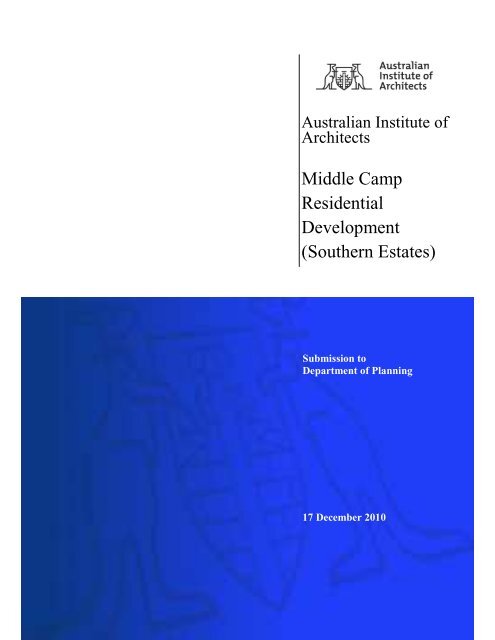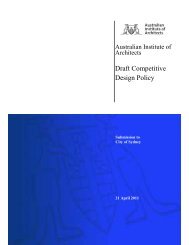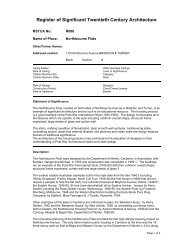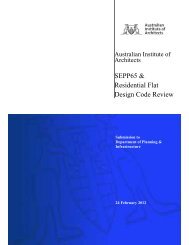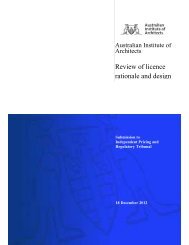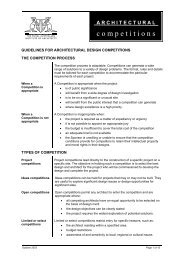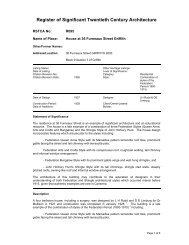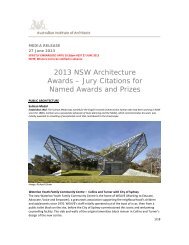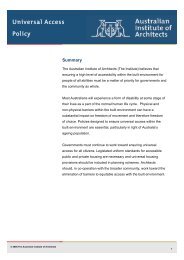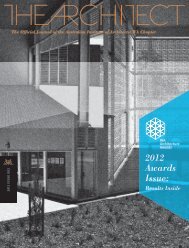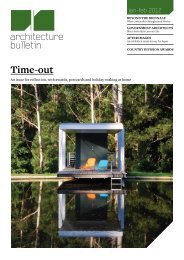Middle Camp Residential Development (Southern Estates)
Middle Camp Residential Development (Southern Estates)
Middle Camp Residential Development (Southern Estates)
You also want an ePaper? Increase the reach of your titles
YUMPU automatically turns print PDFs into web optimized ePapers that Google loves.
Australian Institute of<br />
Architects<br />
<strong>Middle</strong> <strong>Camp</strong><br />
<strong>Residential</strong><br />
<strong>Development</strong><br />
(<strong>Southern</strong> <strong>Estates</strong>)<br />
Submission to<br />
Department of Planning<br />
17 December 2010
SUBMISSION BY<br />
Australian Institute of Architects – NSW Chapter<br />
ABN 72 000 023 012<br />
Tusculum, 3 Manning Street<br />
POTTS POINT NSW 2011<br />
Telephone: 02 9246 4055<br />
Facsimile: 02 9246 4030<br />
email: nsw@raia.com.au<br />
PURPOSE<br />
<br />
<br />
<br />
This submission is made by the NSW Chapter of the Australian Institute of<br />
Architects (the Institute) to the Department of Planning in response to the<br />
applications for a potential State significant site, concept plan<br />
(MP10_0089) and VPA for the <strong>Middle</strong> <strong>Camp</strong> <strong>Residential</strong> <strong>Development</strong><br />
(<strong>Southern</strong> <strong>Estates</strong>) by Coal & Allied.<br />
At the time of the submission the office bearers of the NSW Chapter are:<br />
Brian Zulaikha (President), Dr Deborah Dearing (Immediate Past-<br />
President)*, Joe Agius, Abbie Galvin, Adam Haddow, Ben Hewett,<br />
Esteban Insausti, Chris Jenkins, Steve Kennedy, Matthew Pullinger,<br />
Gerard Reinmuth, Howard Smith, Glen Spicer, David Springett, Agi<br />
Sterling.<br />
The Office Manager of the NSW Chapter is Roslyn Irons. This paper was<br />
prepared by Murray Brown, Policy & Professional <strong>Development</strong> Manager,<br />
for the NSW Chapter’s Built Environment Committee, chaired by Stephen<br />
Buzacott.<br />
INFORMATION<br />
Who is making this submission?<br />
The Australian Institute of Architects (the Institute) is an independent<br />
voluntary subscription-based member organization with approximately<br />
10,153 members who are bound by a Code of Conduct and Disciplinary<br />
Procedures.<br />
<br />
The Institute, incorporated in 1929, is one of the 96 member associations<br />
of the International Union of Architects (UIA) and is represented on the<br />
International Practice Commission.<br />
* Dr Dearing has declared a conflict of interest in regard to this submission<br />
and was not involved in its preparation.<br />
Australian Institute of Architects (NSW)<br />
<strong>Middle</strong> <strong>Camp</strong> <strong>Residential</strong> <strong>Development</strong> (<strong>Southern</strong> <strong>Estates</strong>)<br />
17 December 2010<br />
ii
The Institute’s New South Wales Chapter has 2,959 members, of which<br />
1,700 are registrable architect members – representing 56% of all<br />
registered architects in NSW.<br />
Where does the Institute rank as a professional association?<br />
At 10,153 members, the RAIA represents the largest group of nonengineer<br />
design professionals in Australia.<br />
<br />
Other related organisations by membership size include: The Design<br />
Institute of Australia (DIA) - 1,500 members; the Building Designers<br />
Association of Australia (BDAA) - 2,200 members; the Australian Institute<br />
of Landscape Architects (AILA) 1,000 members; and the Australian<br />
Academy of Design (AAD) - 150 members.<br />
Australian Institute of Architects (NSW)<br />
<strong>Middle</strong> <strong>Camp</strong> <strong>Residential</strong> <strong>Development</strong> (<strong>Southern</strong> <strong>Estates</strong>)<br />
17 December 2010<br />
iii
Australian Institute of<br />
Architects<br />
<strong>Middle</strong> <strong>Camp</strong><br />
<strong>Residential</strong><br />
<strong>Development</strong><br />
(<strong>Southern</strong> <strong>Estates</strong>)<br />
Submission to<br />
Standing Committee on State<br />
<strong>Development</strong><br />
NSW Parliament<br />
Australian Institute of Architects (NSW)<br />
<strong>Middle</strong> <strong>Camp</strong> <strong>Residential</strong> <strong>Development</strong> (<strong>Southern</strong> <strong>Estates</strong>)<br />
17 December 2010<br />
iv
1 THE STATE SIGNIFICANCE THRESHOLD<br />
In its submission regarding the draft South Wallarah Peninsula SEPP dated 25<br />
August 2010 the Institute expressed the view that ‘the SEPP mechanism should only<br />
be used for policies that have state-wide application’ 1 and that site-specific SEPPs do<br />
not meet this threshold.<br />
The same principle applies to the present application for the listing of <strong>Middle</strong> <strong>Camp</strong><br />
as a State significant development site.<br />
In the Institute’s view, both are mechanisms aimed at providing legitimacy for<br />
development proposals that should never have been considered for this<br />
environmentally sensitive area.<br />
2 COAL & ALLIED SOUTHERN ESTATES PROPOSAL<br />
The Executive Summary of the proponent’s Request for Listing – Schedule 3 SEPP<br />
Major <strong>Development</strong> states that ‘Coal & Allied propose to develop 28.2ha of Catherine<br />
Hill Bay (<strong>Middle</strong> <strong>Camp</strong>) for residential development with a maximum yield of 222<br />
dwelling lots. The balance of the Catherine Hill Bay site (526.58ha or 93%) is<br />
proposed to be dedicated to the New South Wales Government for conservation<br />
purposes’. 2 This amounts to a total area of 554.78ha. But this number is at odds with<br />
the total area of 568.93ha quoted on Page 4 of the same document, a difference of<br />
14.15ha.<br />
Despite the Executive Summary’s statement regarding the future conservation status<br />
of 93% of the land the recommended zonings for Catherine Hill Bay include an E4<br />
Environmental Living zone to the east of the existing <strong>Middle</strong> <strong>Camp</strong> village for<br />
‘Attached dwellings where edged heavy black and identified as “Attached dwellings”,<br />
or “Multi dwelling housing” on the Additional Permitted Uses Map’. 3 The Additional<br />
Permitted Uses Map APU 002 in the report appendices does not show the E4 zone,<br />
but it is shown on the Proposed Zones map and the Height of Buildings map. This is<br />
an area specifically identified by the Government-appointed Independent Hearing<br />
and Assessment Panel as unsuitable for development (see below).<br />
3 INDEPENDENT HEARING & ASSESSMENT PANEL RECOMMENDATIONS<br />
The Independent Hearing & Assessment Panel (IHAP) appointed by former Planning<br />
Minister Frank Sartor delivered a report on its findings on 2 June 2008. The IHAP<br />
observed that the <strong>Middle</strong> <strong>Camp</strong> village and its setting represent ‘a precinct of<br />
exceptional aesthetic, landscape, social and cultural landscape heritage<br />
significance… it is unique, representing a largely intact 19 th Century mining village<br />
characterized by development along a single street with single storey cottages sited<br />
on either side. In addition to the cottages themselves the spaces between the<br />
cottages and the landscape setting are also significant’. 4<br />
The IHAP’s observation has been supported and reinforced by the subsequent listing<br />
of Catherine Hall Bay and <strong>Middle</strong> <strong>Camp</strong> on the State Heritage Register.<br />
1 Australian Institute of Architects submission, 25 August 2010<br />
2<br />
Coal & Allied/Urbis Catherine Hill Bay SSS Listing Report, November 2010, p. 1<br />
3 Coal & Allied/Urbis Catherine Hill Bay SSS Listing Report, November 2010, p. 31<br />
4 Independent Hearing & Assessment Panel Key Planning Principles Report, 2 June 2008, p.7<br />
Australian Institute of Architects (NSW)<br />
<strong>Middle</strong> <strong>Camp</strong> <strong>Residential</strong> <strong>Development</strong> (<strong>Southern</strong> <strong>Estates</strong>)<br />
17 December 2010<br />
1
While acknowledging ‘that there is potential for residential development’ in the areas<br />
to the north and north-west of <strong>Middle</strong> <strong>Camp</strong> village known as Sawmill <strong>Camp</strong> and<br />
Colliery Hamlet, the IHAP also recommended that ‘development should not proceed’<br />
in precincts to the south west and south east, ‘having regard to the significance of<br />
this land in providing a visual, cultural and landscape connection between <strong>Middle</strong><br />
<strong>Camp</strong> Village in the north and Catherine Hill Bay Village in the south’. 5 The E4 zone<br />
identified in SSS Listing Report is the south-east area identified as unsuitable by the<br />
IHAP.<br />
The Institute supports the IHAP’s recommendation that the E4 zone is unsuitable for<br />
development.<br />
4 DEVELOPMENT CONDITIONS<br />
The Institute is not opposed to development in the existing <strong>Middle</strong> <strong>Camp</strong> village, but<br />
considers that development should be incremental and spaced over a lengthy period<br />
of time and in sympathy with the existing modest one-storey character of the area.<br />
The Institute’s view is that intensive residential development of the kind proposed by<br />
Coal & Allied at Sawmill <strong>Camp</strong> and Colliery Hamlet is inappropriate for this remote<br />
location and should not proceed; if it does the Institute supports the following<br />
recommendation by the IHAP that the development:<br />
‘(a) be contained to previously disturbed lands or lands adjoining disturbed<br />
areas that are not of heritage, environmental, ecological or scenic<br />
significance;<br />
(b) ensure adequate separation from the existing <strong>Middle</strong> <strong>Camp</strong> Village to<br />
preserve the integrity and setting of the existing village;<br />
(c) be designed according to best practice planning principles;<br />
(d) be screened from view from Flowers Road, the beach, the existing village<br />
of <strong>Middle</strong> <strong>Camp</strong>, the existing village of Catherine Hill Bay and other<br />
significant vista points;<br />
(e) provide for a significant landscape buffer (minimum 30 metres) separating<br />
the development from Flowers Drive, <strong>Middle</strong> <strong>Camp</strong> Village and any new<br />
proposed bypass road; and<br />
(f) provide for development within a landscape setting by retaining significant<br />
trees and minimising tree loss. A Significant Tree audit should be<br />
conducted and this should inform the final subdivision layouts and<br />
permissible building areas on each lot.’ 6<br />
.<br />
5 DESIGN EXCELLENCE<br />
The applications propose insufficient controls aimed at achieving the highest possible<br />
level of design excellence for future development, given the State Heritage Register<br />
listing and the environmental sensitivity of the area. Urban design guidelines are not<br />
enough; a site-specific development control plan should also be prepared.<br />
The Institute also considers that it is inappropriate to apply the Exempt and<br />
Complying <strong>Development</strong> SEPP for development in this area. The merit-based<br />
5 Independent Hearing & Assessment Panel Key Planning Principles Report, 2 June 2008, p.8<br />
6 Independent Hearing & Assessment Panel Key Planning Principles Report, 2 June 2008, pp 8/9<br />
Australian Institute of Architects (NSW)<br />
<strong>Middle</strong> <strong>Camp</strong> <strong>Residential</strong> <strong>Development</strong> (<strong>Southern</strong> <strong>Estates</strong>)<br />
17 December 2010<br />
2
assessment process should be mandatory. In addition, a design review panel should<br />
be established to provide high level design advice to the consent authority.<br />
Australian Institute of Architects (NSW)<br />
<strong>Middle</strong> <strong>Camp</strong> <strong>Residential</strong> <strong>Development</strong> (<strong>Southern</strong> <strong>Estates</strong>)<br />
17 December 2010<br />
3


